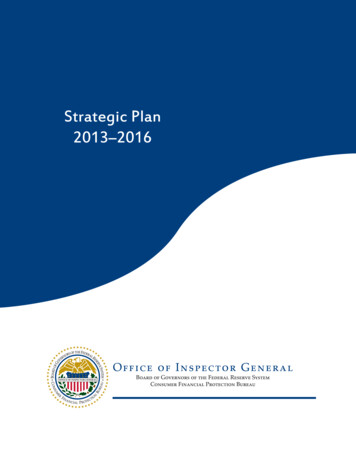
Transcription
Ministry of HealthMinistry of Health, GUYANAStrategic Plan: NCDPrevention and Control2013 - 2020GUYANAStrategic Plan 2013-2020: IntegratedPrevention and Control of Non CommunicableDisease in GuyanaLot 1 BrickdamGeorgetownGUYANAJuly 20131
Ministry of Health, GUYANAStrategic Plan: NCDPrevention and Control2013 - 2020Ministry of HealthGuyanaGUYANA STRATEGIC PLAN FOR THE INTEGRATEDPREVENTION AND CONTROL OF CHRONIC NONCOMMUNICABLE DISEASES AND THEIR RISKFACTORS2013 - 2020Georgetown20132
Ministry of Health, GUYANAStrategic Plan: NCDPrevention and Control2013 - 2020Table of ContentsFOREWORDACKNOWLEDGEMENTS4LIST OF ACRONYMS5BACKGROUND6SITUATIONAL ANALYSIS9EPIDEMIOLOGY10RISK FACTORS FOR NCD'S20COUNTRY RESPONSE33FRAMEWORK FOR ACTION48RISK FACTOR REDUCTION AND HEALTH PROMOTION &DISEASE PREVENTION50INTEGRATED MANAGEMENT CHRONIC DISEASES & RISK FACTORS53SURVEILLANCE57PUBLIC POLICY, ADVOCACY AND COMMUNICATION58PROGRAM MANAGEMENT61RESULTS LOG FRAME64REFERENCES93Appendix 1: Port of Spain Declaration96Appendix 2: Chronic Care Model983
Ministry of Health, GUYANAStrategic Plan: NCDPrevention and Control2013 - 2020AcknowledgementsThis strategy was developed by Dr Karen Boyle, the Coordinator of the Chronic Disease Unit,Ministry of Health and former PAHO/WHO consultant. A special thanks to Dr Shamdeo Persaud,Chief Medical Officer, Ministry of Health, and Ms Karen Roberts, Consultant, Non-communicableDiseases, PAHO/WHO, for their support in the finalizing of this strategy. Additionally, a sincerethank you to the following individuals:Mr. Charles Fung-a FattMs. Lorene BairdMr. Alfred KingMs. Dionne BrowneMs. Penelope HarrisDr. Claudette HarryDr. Maxine SwainDr. Morris EdwardsMs. Nikita BostonMs. Roxanne BourneDr. Shamdeo PersaudDr. Julian AmsterdamDr. Irv ChanMs. Jewel SearsMs. Winifred GoodridgeMr. Wilton BennMs. Abigail CalebMs. Ninian BlairDr. Janice WoolfordDr. Sheik AmirDr. Mandissa SealeyMr. Joseph HamiltonDr. Colin RoachMs. Joyce White ChinDr. Kampta PrashadNurse EdwardsMr. Andrew BoyleMs. Fiona LegallMs. Rosemary BenjaminMs. Annette GoodingMs. Colette Benn-AlphonsoDr. Vivienne MitchellMs. Elizabeth AlleyneMr. Adrianus VlugmanMs. Cornelly McAlmontDr. Rudolph CummingsMs. Rolinda KirtonMs. Aileen Nester-FordeMs. Renee Franklin-.PerouneDr. Indira BhojMs. Kesaundra AlvesMs. Karen YawMr. Davin Washington4Dep. Chief Parliamentary Council Attorney General OfficePermanent Secretary Ministry of LaborPermanent Secretary Ministry of Culture Youth and SportSchool Health and Nutrition Program, Min. of EducationPrincipal of Carnegie School of Home EconomicsGuyana Kidney FoundationGuyana Diabetes AssociationEpidemiologist, Ministry of Health,Health Education Unit Ministry of HealthTechnical Officer Guyana Bureau of StandardsChief Medical Officer, Ministry of Health (MoH)Director, Standards MoHDirector, Regional Health Services, MoHDirector, Food and Drugs DepartmentStatistical Unit, MoHDirector, Health Sciences EducationFood Policy Division MoHDirector, Food Policy Division MoHDirector, Maternal and Child Health ServicesDirector. Medical and Professional Services GPHCDirector. Medical OutpatientsParliamentary SecretaryDirector, the National Reference LaboratoryNational Coordinator, Laboratory ServicesDirector, Campbellville Health CenterNurse in Charge, Sophia Health CenterDirector Eureka Medical LaboratoriesManager Cancer InstituteChairperson Periwinkle ClubFounder member Periwinkle ClubQuality Assurance Officer/Cancer SurvivorMedical Advisory Committee, Ministry of HealthExecutive Director Private Sector CommissionSnr. Advisor, Sustainable Development and Env. PAHO/WHOUNICEFHealth Sector, CARICOMManager, The Guyana Diabetes and Foot care ProjectAgriculture Program Officer, Ministry of AgricultureSenior Project Officer, Health Sector CARICOMManager, DFC GPHCAttorney at LawDirector, Planning Unit MoHMinistry of Local Government
Ministry of Health, GUYANAStrategic Plan: NCDPrevention and Control2013 - 2020List of AcronymsARI- acute respiratory infectionsBMI- body mass indexCARMEN- Collaborative Action for Risk Factor Reduction and Effective Managementof NCDsCARPHA- Caribbean Regional Public Health AuthorityCBO- community based organizationsCCHIII- Caribbean Cooperation in Health IIICEHI- Caribbean Environmental Health InstitutionCFNI - Caribbean Food and Nutrition InstituteCRDTL Caribbean Regional Drug Testing LaboratoryCWD-Caribbean Wellness DayDALYs - Disability Adjusted Life YearsFBO- faith based organizationsFCTC - Framework Convention on Tobacco ControlGDP- gross domestic productGPHC- Georgetown Public Hospital CorporationIIWCC - International Inter-professional Wound Care CommitteeMoCYS-Ministry of Culture, Youth and SportMoA-Ministry of AgricultureMoH- Ministry of HealthMoLHSSS- Ministry of Labor Human Services and Social SecurityNIS - National Insurance Scheme PoliciesNCDs- non-communicable diseasesNGO- non-governmental organizationsPA- physical activityPE- physical educationPPP- public, private partnershipsPOS- Declaration of Port of SpainRHA- Regional Health AuthoritiesSHS- second hand smokeSTEPS- Stepwise Approach to Chronic Disease SurveillanceTMRI- Tropical Medicine Research InstituteVIA - Visual Inspection using Acetic AcidWHA- World Health AssemblyWHO- World Health Organization5
Ministry of Health, GUYANAStrategic Plan: NCDPrevention and Control2013 - 2020BackgroundChronic Non-communicable Diseases (NCDs) are recognized as a growing internationalsocio economic and public health problem, accounting for over 36 million of the 57million deaths worldwide in 2008i. Of these deaths, 80% originated in the low and middleincome countries. NCDs and non-intentional injuries represent nearly 70% of all causesof death in the Region of the Americas, mostly affecting those 18-70 years old. TheCaribbean epidemic of chronic diseases - in particular, cardio vascular disease, diabetes,cancer and asthma- is the worst in the region of the Americasii These diseases arepreventable: “Up to 80% of heart diseases, stroke, and type 2 diabetes and over a third ofcancers could be prevented by eliminating shared risk factors, such as tobacco use,unhealthy diets, physical inactivity and the harmful use of alcohol.”iiiIn 2005, the Conference of Heads of Government in CARICOM took a decision toconvene a Summit that would facilitate a multi-sector, comprehensive and integratedresponse to the issue of NCDs in the Caribbean. In September 2007, at the CARICOMSummit on Chronic Non-communicable Diseases (NCDs) the Declaration of Port ofSpain (POS) was pronounced with the theme of “Uniting to Stop the Epidemic of ChronicNon-communicable Diseases”iv. This declaration provided a framework for policies andprogrammes across government ministries, the private sector, civil society, the media,non-governmental organizations (NGOs), academia and the community, “to make theright choice the easy choice.”vIn recognition of the growing burden of NCDs and the huge threat they place on worlddevelopment, on 24th May 2012, at the 65th World Health Assembly, a resolution wasmade and supported by over 50 countries to “adopt a global target of a 25% reduction inpremature mortality from NCDs by 2025.”The 2010-2015 Regional Health Framework of the Caribbean Cooperation in Health III(CCH III) recognizes the importance of “Investing in Health for SustainableDevelopment.”6
Ministry of Health, GUYANAStrategic Plan: NCDPrevention and Control2013 - 2020The vision for the NCD strategy is in keeping with the Ministry of Health’s (MoH) vision“for Guyanese citizens to be among the healthiest in the Caribbean and the Americas”The principles of the strategy are in sync with those of the MoH and the CCH III: The right to the highest attainable level of health and therefore the provision ofservices commensurate with needs Equity in access to quality health services regardless of origin, ethnicity, gender,geographic location or socio-economic status Solidarity between member countries-working together to define and achievecommon good People centered – primary goal of meeting the needs of the people, families andcommunities Leadership in the public health sector that focuses on the attainment of health forall and a shared vision that creates an enabling environment for mobilizingresources, improving performance and ensuring greater cooperation andaccountability within the regionvi. The CCH provides a mechanism for smallmember states to share “rare” medical specialists that are in demand within theregion e.g. oncologists and endocrinologists.CARICOM member states have embraced a Primary Health Care Approach as the overarching health development framework. This approach emphasizes the decentralizationof the administration and provision of an essential package of primary health services toensure equity in access to most, rather than investing huge sums into centrally located,tertiary health services that are affordable and accessible to few.Guyana has observed a growing epidemic of NCDs which is in part a reflection of theeffects of globalization, increased urbanization, population ageing, behavioral andlifestyle change, and the inadequacies of existing health promotion, disease prevention,diagnosis and management efforts.7
Ministry of Health, GUYANAStrategic Plan: NCDPrevention and Control2013 - 2020NCDs can undermine the potential of an individual to earn a living or provide forthemselves and family. Vulnerable populations are more likely to develop chronicdiseases and low-income families are more likely to become further impoverished as aresult of them. The World Health Organization’s 2008-2013 Action Plan for the GlobalStrategy for the Prevention and Control of Non-communicable Diseases emphasized theneed for policies to protect the poor from the disproportionate burden of NCDs theycarry. Furthermore, the action plan highlighted the need for investing in NCD preventionas an integral part of sustainable socioeconomic development. In recognition of thepotential threat chronic diseases pose to socioeconomic development, the Government ofGuyana is committed to investing in health sector development to ensure universal accessto quality prevention, care and treatment services.“Whole-of government-whole- of –society effort” WHA, Declaration of 2011The health sector in Guyana is striving to build strategic partnerships with otherministries, civil society and the private sector to implement a comprehensive andintegrated approach to preventing and mitigating the impact of NCDs. This is inalignment with the WHO 2008-2012 Global Action Plan that emphasizes the need forwhole government involvement and the crucial role of non-health sector participation andpolicies to effectively address NCDs. The World Health Assembly of 2011 recommended“strong leadership and multi-sectoral approaches for health at the government level,including, as appropriate, health in all policies and whole-of-government approachesacross such sectors as health, education, energy, agriculture, sports, transport,communication, urban planning, environment, labour, employment, industry and trade,finance and social and economic development.”This strategic plan for NCDs utilizes the Caribbean Strategic Plan of Action for thePrevention and Control of NCDs as a framework to address the top four causes ofpremature death in Guyana: cardiovascular diseases, cancer, diabetes and chronicrespiratory diseases ensuring a multi-sectoral, integrated approach is maintained.8
Ministry of Health, GUYANAStrategic Plan: NCDPrevention and Control2013 - 2020SITUATIONAL ANALYSISAdministrationResponsibility for health services in Guyana is being devolved from the Ministry ofHealth Central to Regional Health Authorities (RHA), and to Georgetown PublicHospital Corporation (GPHC)vii. Regional Health Authorities were established under theRHA Act 2005 (and the Public Corporations Act in the case of GPHC) and serve ascorporations contracted to deliver health services under the supervision and regulation ofthe Ministry of Health. RHA contracts specify the level and quality of services theyshould provide in return for the funding they receive. RHAs are established in Regions 4and 6 while the remaining regional services are administered under the Regional HealthServices Department of the MoH.Economic Burden of NCDs in GuyanaIn 2011MoH/PAHO conducted a cost of illness assessment for NCDs using data fromlocal and international sources and found that: the annual direct costs of treating diabetes and/or hypertension are estimatedbetween US 7.2 million and US 10.8 million, with clinic visits and laboratorytests accounting for the highest burden of cost the annual direct cost of treating cancers and cardiovascular diseases areestimated between US 0.3million and US 5.2million with treatment and drugsaccounting for the highest burden of cost annual indirect costs of all NCDs are estimated between US 207.5million, 10%of GDP in 2010 9total annual costs accruing due to NCDs are estimated at US 221.5million
Ministry of Health, GUYANAStrategic Plan: NCDPrevention and Control2013 - 2020EpidemiologyMortality from NCDsIn 2005, an estimated 35 million people worldwide died from chronic diseases; this isdouble the number of deaths from all infectious diseases. While deaths from perinatalconditions and nutritional deficiencies are expected to decline by 3 % over the next 10years, deaths due to chronic diseases are projected to increase by 17 % by 2015 viii. Overthe last decade, ischemic heart disease, cerebrovascular disease and diabetes have beenamong the top five leading causes of death.Table 1 Six Leading Causes of Death in Guyana from 2000 and 2009Cause of rovascular Diseases12213Ischemic Heart Diseases21121Neoplasms33434HIV Diseases (AIDS)66542Diabetes Mellitus44355Hypertensive Disease55665Source: Adapted from MOH Statistics Bulletin, 2008A review of Ministry of Health statistical data shows that heart disease, external causes,cancer, diabetes mellitus, and chronic liver disease have accounted for over 2,000 deathsper annum since 2004ix. MoH stats show that NCDs accounted for over 60% of deathsamongst males and over 70% of deaths amongst females in 2009.Major causes of death by age group are as follows:-Under 1 year: Respiratory diseases was the #1 cause-Under 5 years: perinatal causes, acute respiratory infections (ARI), acutediarrhoeal disease and and
Ministry of Health, GUYANAStrategic Plan: NCDPrevention and Control2013 - 2020-15-44 years: HIV/AIDS, accidents/injuries, suicide, ARI and diarrhoea disease.-45-64 years: ischaemic heart disease, cerebrovascular disease, diabetes, cancer.Table 2 Major causes of death by age groupTable 3 Mortality by Cause &Sex 2009Source: Ministry of Health Statistical Bulletin 200911
Ministry of Health, GUYANAStrategic Plan: NCDPrevention and Control2013 - 2020Table 4 Percentage of Mortality by Cause and Sex 2009-Source: Ministry of Health Statistical Bulletin 2009Premature death due to injuries and accidents were three times higher in males than infemales. Chronic Non-communicable Diseases Cerebrovascular disease (Stroke) was thenumber one cause of death overall in 2009- 13.1% followed by Ischemic Heart Disease13% and neoplasms 8.9%.Figure 1-Mortality Rates for type II Diabetes by sex 2001-2006Source: PAHO Gender Analysis NCDs in Guyana 2011 and MOH statistical Bulletin 200912
Ministry of Health, GUYANAStrategic Plan: NCDPrevention and Control2013 - 2020Figure 2- Mortality Rates for Type I Diabetes by sex in Guyana 2001-2006Source: PAHO gender Analysis of NCDs in Guyana 2011and MoH Statistical BulletinCancer MortalityIn 2004, prostate cancer accounted for the highest mortality rate due to cancer, followedby cancers of the breast, cervix, colon, stomach, lung and liver in descending order.Figure 3: Mortality rate by cancer sites 200414 13.11210RATE X est mortality rates occurred in patients over 65 years old in both sexes. There hasbeen a steady increase in mortality due to genital cancer and breast cancer in women13
Ministry of Health, GUYANAStrategic Plan: NCDPrevention and Control2013 - 2020from 2001- 2008. A 56% increase in mortality from cervical cancer from 2001 to 2008(MoH Stats).Disability Adjusted Life Years (DALYs)Non-communicable Diseases, as a group, are the main contributor to the burden ofdisease, accounting for 46.9 % of all Disability Adjusted Life Years (DALYs) lost in2000. Out of this, neuro-psychiatric disorders caused 16.4 % and cardiovascular diseases,diabetes and malignant neoplasms accounted 13.3 %.Asthma caused significantmorbidity and was ranked 16th among the leading causes of lost DALYs and 6th amongthe leading causes of DALYs in 2000, causing 1.3 % and 2.5 % respectively.Table 5 Disability Adjusted Life Years (DALY's) for Latin America and theCaribbeanSource: ata on some chronic diseases such as sickle cell anemia is not routinely collected and assuch, a special survey to determine the burden of this disease will be needed. Data onsickle cell disease prevalence is relevant to this strategy as complications of sickle celldisease include pulmonary fibrosis, kidney failure, stroke and retinopathy which can alsobe complications of diabetes, hypertension or dyslipidemia, For this reason and because14
Ministry of Health, GUYANAStrategic Plan: NCDPrevention and Control2013 - 2020of an over 40% afro and mixed population base, sickle cell disease will also be includedin the Guyana-specific strategy for NCDs.Morbidity due to NCDsFigure 4: Incidence of first visits to health facilitiesSource: WHO Economic Burden of NCDs in Guyana, 2011 based on 2009 dataFigure 5 - Four weekly Chronic Disease Report by sex, MoH 200915
Ministry of Health, GUYANAStrategic Plan: NCDPrevention and Control2013 - 2020Hypertension and diabetes are the leading causes for patients to attend chronicdisease clinics in Guyana.NCDs can go undiagnosed and this can be due to multiple factors including poor uptakeof health services by persons who feel “well”, failure of providers to screen new andexisting patients for NCDs or their complications, miss- diagnosis, and possibleweaknesses in the surveillance and reporting system.HypertensionThere has been an increase in the incidence of hypertension in Guyana from 2001 to 2011(See Figure 6 below). There are around 15,000 new cases of hypertension diagnosed eachyear and a higher prevalence is found in people older than 50. Hypertension is associatedwith a high mortality and is the fifth leading cause of death in Guyana.Figure 6: Incidence of Hypertension in Guyana 5055817984767713,034914765 595637835498511410,0916754ALL AGES1501311331162861562828,24819192CancerThe incidence of cancer in Guyana has increased over the period 2000-2011. Theprincipal cancers were breast (15.4 %), prostate (14.6%) and cervical (12.9 %). Whereas16
Ministry of Health, GUYANAStrategic Plan: NCDPrevention and Control2013 - 2020in 2009 prostate- 38% (male), breast-23% (female), cervical- 21% (female), intestinal-9%(both sexes),lung-2% and all other-4% (MoH Stats). The annual figures are shown in thetable 6.Table 6: Incidence of cancer by year 2000 - 323218588139.4TOTAL3453934495744742236100.0Figure 7 - Incidence of cancers by gender in Guyana, GLOBOCAN Estimates 2008Source: PAHO, Economic burden of NCDs in Guyana, 201117
Ministry of Health, GUYANAStrategic Plan: NCDPrevention and Control2013 - 2020Chronic Respiratory DiseasesTable 7 - Four weekly Asthma and Respiratory Diseases report by sex, 2009Source: MoH 2009, Statistical bulletin –Reflects cumulative total number of visits to health facilities andnot the absolute number of individuals seenSyndrome tal0-4Females3,4866895-1415-4445-6465 710,9782,228The prevalence of asthma in the Caribbean is high and rising, with significant morbidityand mortality, despite the existence of evidence based protocols for its management andcontrol. Guyana has developed and trained doctors on its Standard Treatment Guidelinesfor Primary Health Care which captures the management of the common NCDs.However there remains a need for protocols and flow charts to guide the generalmanagement of a NCD case ensuring linkages to other services and screening forcomplications. Chronic Respiratory Diseases accounted for 28.5% and 23% of the maleand female burden of NCDs respectively in the year of 2009.DiabetesApproximately 74 % of all people with diabetes are in their productive years i.e. under 65years and more females than males are affected. Each year an average of over 7,000 newcases of diabetes are diagnosed across Guyana.18
Ministry of Health, GUYANAStrategic Plan: NCDPrevention and Control2013 - 2020Table 8 - Four weekly diabetes report by sex, 2009Syndrome TotalMalesTotal0-4Females5-1415-4445-6465 urce: MoH 2009, Statistical bulletin. Reflects cumulative total number of visits tohealth facilities and not the absolute number of individuals seenTHE LINKS BETWEEN TUBERCULOSIS AND DIABETES People with a weak immune system, as a result of chronic diseases such asdiabetes, are at a higher risk of progressing from latent to active TB. People with diabetes have a 2-3 times higher risk of TB compared to peoplewithout diabetes. All people with TB should be screened for diabetes.People with diabetes who are diagnosed with TB have a higher risk of death during TBtreatment and of TB relapse after treatment.The National Tuberculosis Programme in Guyana started screening all TB patients forDiabetes in 2010. In 2010 7% of the new TB patients were found to be diabetics and in2012 4.8% of the new TB patients were diabetics. TB patients with diabetes are placed onWHO recommended treatment like all other categories of TB patients.19
Ministry of Health, GUYANAStrategic Plan: NCDPrevention and Control2013 - 2020Risk Factors for NCD’sFigure 10 Determinants of four NCDs in GuyanaGlobalization, Macro economics, National Politics,UrbanizationSocial ClassGenderEthnicityHealthy PublicPoliciesPlace, HousingOccupational RisksAccess to servicesCommunity & PSInterventionsLife StylesSmokingNutritionPhysical InactivityPsychosocial FactorsPrimaryPreventionPhysiologicalFactorsHigh Blood PressureHigh onic Respiratory DiseasesCardiovascular Disease, StrokeDiabetes Mellitus and their complicationsPS- Private Sector20
Ministry of Health, GUYANAStrategic Plan: NCDPrevention and Control2013 - 2020Risk factors for chronic diseases can be divided into physiological, behavioral orlifestyle, social and environmental influences. Most of the behavioral and lifestylefactors are amenable to modification through education, sensitization, social learning.Man, however is a social being and there are social, economic and political factors thatcan facilitate or serve as barriers to an individual having the agency to make healthychoices. It is important to appreciate the social determinants of health in order to addressthem effectively and systematically.PhysiologicalPhysiological factors causing chronic diseases can be non-modifiable - age, gender andfamily history or genetic constitution and modifiable factors such as high blood pressure,obesity, high blood sugar and cholesterol.The Life Course Approach to chronic diseases recognizing the long term sequelae to inutero- stressors such maternal malnutrition and the emergence of the thrifty phenotype :at birth and/or in early infant life -decreased growth, and increased risk for type 2diabetes and metabolic syndrome in adulthood. Low birth weight has been found to leadto increased risk for hypertension, obesity and diabetes in adulthoodx. Based on thisunderstanding, any preventative interventions concerning NCDs should include antenataland early childhood development interventions. Stunting is lower among children whosemothers have more than secondary education (16 percent) and highest among childrenfrom Interior locations (35 percent)xi. Rates of low birth weight in Guyana haveincreased from 11.2% in 2000 to 18.9% in 2006xii. MOH figures report 13% of babiesborn in 2008 weighed less than 2,500g. Almost one in five children (18 percent) underage 5 is short for age or stunted.The 2009 Demographic and Health Survey found that the prevalence of anemia is highestfor children 9-11 months (74 percent) and lowest for those 36-59 months (25 to 28percent). The percentage of children with anemia is lowest among children of motherswith secondary or higher education (38-40 percent) and among children of mothers in thehighest wealth quintile (32 percent). These findings suggest that:1) the education of21
Ministry of Health, GUYANAStrategic Plan: NCDPrevention and Control2013 - 2020mothers in general, 2) the focused effort to teach mothers in Interior locations theimportance of balanced diets, supplements and anti-helminthes and 3) provision ofaccessible, culturally appropriate primary health services are critical to preventingstunting and anemia in our children.Past socioeconomic status and nutrition during childhood and development influence theheight attainable as an adult. Low pre-pregnancy BMI and short stature are risk factorsfor poor birth outcomes and obstetric complicationsxiii.ObesityTable 9 Four weekly obesity and malnutrition reports, 2009 -Reflects cumulative totalnumber of visits to health facilities and not the absolute number of individuals 465 TotalObesity3455494542316316175894Malnutrition 11516010128614441275Source: MoH 2009, Statistical bulletinGuyana not unlike its Caribbean counterparts, has observed a rising trend in obesity andother forms of malnutrition. Obesity was shown to be a growing concern in adults in boththe 1997 micronutrient survey and the1999 Physical Activity Survey in Guyana. Thephysical activity survey showed 51% of adults over age 20 had a BMI of 25 and higher,and 22.4% of them were classified as obese (BMI 30). Significantly more women thanmen were obese (20% vs. 6%). The prevalence of obesity increased with age, withpersons 50-64 years old having three times higher levels of obesity than those aged 20-30(33% vs. 11%). The Global School-Based Student Health Survey of 2010 found 15.9% ofgirls and 14.6% of boys aged 13-15 years were overweight and 3.6% of girls and 4.6% boysof the same age group were obesexiv.The Demographic and Health Survey reported 6% ofchildren under the age of 5 are overweight in Guyana.22
Ministry of Health, GUYANAStrategic Plan: NCDPrevention and Control2013 - 2020WHO rationale for the surveillance of overweight and obesity(xii): Obesity increases the risks of cancer of the breast, colon, prostate, endometrium,kidney and gall bladderxv. Overweight and obesity lead to adverse effects on blood pressure, cholesterol,triglycerides and insulin resistance. Risks of coronary heart disease, ischemicstroke and type 2 diabetes mellitus increase with increasing BMIxviRaised blood pressureWHO rationale for the surveillance of elevated blood pressurexvii: Raised blood pressure is a huge risk factor for coronary heart disease andischemic and hemorrhagic strokexviii The risk of cardiovascular disease doubles for each increment of 20/10 mmHg ofblood pressure, starting at 115/75mmHgxix Complications of raised blood pressure include heart failure, peripheral vasculardisease, renal impairment, fundal hemorrhages, and papillodemaxx Treating systolic and diastolic blood pressures to targets that are less than 140/90mmHg is associated with a decrease in cardiovascular complicationsxxi Staging the management of hypertension:Raised blood glucoseWHO recommends surveillance for elevated blood glucose because it is a seriousmetabolic disorder that can insidiously damage microcirculation and nerve cells, oftengoing unnoticed until irreparable damage has occurred. Early detection and adequatemanagement of DM are required to reduce the incidence of peripheral neuropathies,amputations, chronic leg ulcers, blindness, loss of productivity and ultimately, prematuredeath.Two or more fasting blood glucose levels of 126mg/dl or a random blood glucose of or equal to 200mg/dl are used to define diabetes in Guyana. Alternatively, a 2 hour23
Ministry of Health, GUYANAStrategic Plan: NCDPrevention and Control2013 - 2020glucose tolerance test of over 200mg/dl can be used. Screening for Pre-diabetes can beextremely beneficial including follow up with women with h/o Gestational diabetes.HbA1C is the preferred method to monitor the management of diabetes.Abnormal blood lipidsTesting for lipid profiles is not readily available in the public sector though its utility isreadily recognized. The magnitude of this problem in Guyana is not quite known due tothe unavailability of reliable data. No national surveys or studies on the prevalence ofdyslipidemia have been done in Guyana. The link between high blood lipids and thedevelopment of coronary heart disease and ischemic cerebrovascular disease has beenestablished.BehavioralThe physiological risks which lead to chronic diseases are caused mainly by modifiable,lifestyle-related, socially –determined behavioral risk factors, namely unhealthy diet,physical inactivity, tobacco use and harmful use
NIS - National Insurance Scheme Policies NCDs- non-communicable diseases NGO- non-governmental organizations PA- physical activity PE- physical education PPP- public, private partnerships POS- Declaration of Port of Spain RHA- Regional Health Authorities SHS- second hand smoke STEPS- Stepwise Approach to Chronic Disease Surveillance











